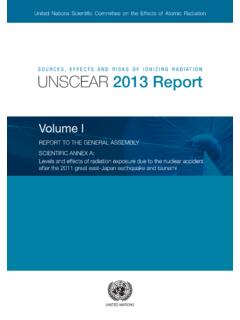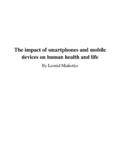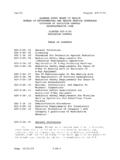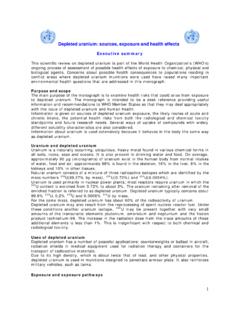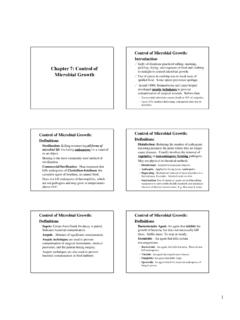Transcription of SOURCES AND EFFECTS OF IONIZING RADIATION
1 SOURCES AND EFFECTSOF IONIZING RADIATIONU nited Nations Scientific Committee on the EFFECTS of Atomic RadiationUNSCEAR 2000 Report to the General Assembly,with Scientific AnnexesVOLUME I: SOURCESUNITED NATIONSSOURCES AND EFFECTSOF IONIZING RADIATIONU nited Nations Scientific Committee on the Effectsof Atomic RadiationUNSCEAR 2000 Report to the General Assembly,with Scientific AnnexesUNITED NATIONSNew York, 2000 NOTEThe report of the Committee without its annexes appears as Official Records of theGeneral Assembly, Fifty-fifth Session, Supplement No.
2 46 (A/55/46).The designation employed and the presentation of material in this publication do notimply the expression of any opinion whatsoever on the part of the Secretariat of the UnitedNations concerning the legal status of any country, territory, city or area, or of its authorities,or concerning the delimitation of its frontiers or country names used in this document are, in most cases, those that were in useat the time the data were collected or the text prepared. In other cases, however, the nameshave been updated, where this was possible and appropriate, to reflect political NATIONS PUBLICATIONS ales No.
3 92-1-142238-8 CONTENTSPageVOLUME I:SOURCESR eport of the United Nations Scientific Committee on theEffects of Atomic RADIATION to the General 1 Scientific AnnexesAnnex assessment 19 Annex from natural RADIATION 83 Annex to the public from man-made SOURCES of RADIATION RADIATION II: EFFECTSA nnex repair and mutagenesisAnnex EFFECTS at low RADIATION dosesAnnex EFFECTS of RADIATION and other agentsAnnex evaluation of RADIATION -induced cancerAnnex and EFFECTS of the Chernobyl accidentReport of the United Nations Scientific Committeeon the EFFECTS of Atomic Radiationto the General AssemblyReport of the United Nations Scientific Committeeon the EFFECTS of Atomic Radiationto the General AssemblyCONTENTSPageINTRODUCTION.
4 RADIOLOGICAL CONSEQUENCESOFTHECHERNOBYLACCIDENT .. RADIATION .. 8 III. RADIATION -ASSOCIATED EFFECTS AFTER LOW DOSES OF RADIATION .. 11 III. THE CHERNOBYL .. 14 Appendix I:Members of national delegations attending theforty-fourthtoforty-ninthsessions .. 16 Appendix II:Scientific staff and consultants cooperating with theUnited Nations Scientific Committee on the EFFECTS of Atomic Radiationinthepreparationofthepresentrep ort .. 17 REPORT TO THE GENERAL the past few years, the United Nations ScientificCommittee on the EFFECTS of Atomic Radiation1has under-taken a broad review of the SOURCES and EFFECTS of ionizingradiation.
5 In the present report,2the Committee, drawing onthe main conclusions of its scientific assessments, summar-izes the developments in RADIATION science in the years leadingup to the new present report and its scientific annexes wereprepared between the forty-fourth and the forty-ninthsessions of the Committee. The following members of theCommittee served as Chairman, Vice-Chairman andRapporteur, respectively, at the sessions: forty-fourth andforty-fifth sessions: L. Pinillos-Ashton (Peru), A. Kaul(Germany) and G.
6 Bengtsson (Sweden); forty-sixth andforty-seventh sessions: A. Kaul (Germany), Holm(Sweden) and J. Lipsztein (Brazil); and forty-eighth andforty-ninth sessions: Holm (Sweden), J. Lipsztein(Brazil) and Y. Sasaki (Japan). The names of members ofnational delegations who attended the forty-fourth to theforty-ninth sessions of the Committee as members ofnational delegations are listed in Appendix Committee wishes to acknowledge the help andadvice of a group of consultants and contributors whohelped in the preparation of the scientific annexes (seeAppendix II).
7 The sessions of the Committee were attendedby representatives of the World Health Organization andthe International Atomic Energy Agency. The Inter-nationalCommissiononRadiationUnits andMeasurements and the International Commission onRadiological Protection were also represented. TheCommittee wishes to acknowledge their contributions tothe carrying out its work, the Committee applied itsscientific judgement to the material it reviewed and took careto assume an independent and neutral position in reaching itsconclusions.
8 The results of its work are presented for thegeneral reader in this report to the General Assembly. Thesupporting scientific annexes are aimed at the generalscientific United Nations Scientific Committee on the Effectsof Atomic RADIATION , a scientific committee of the GeneralAssembly, is the body in the United Nations system with amandate to assess and report levels and EFFECTS of exposure toionizing RADIATION . The fact that the Committee holds thisspecific mandate from such an authoritative body greatlyenhances its ability to provide an effective and independentservice to the world.
9 The United Nations, through the GeneralAssembly, can take credit for providing that service. Theinformation provided by the Committee assists the GeneralAssembly in making recommendations, in particular thoserelevant to international collaboration in the health field, tosustainable development and, to some extent, to themaintenance of international peace and challenges as regards global levels of radiationexposure continue to arise and new biological informationon the EFFECTS of RADIATION exposure is becoming example.
10 Large amounts of radioactive waste have builtup as a result of both peaceful uses of nuclear energy andmilitary nuclear operations, and RADIATION SOURCES used inmilitary and peaceful operations have been abandoned,creating a situation that is prone to illicit trafficking andother criminal activities. Moreover, the potential risks fromlow-level RADIATION exposure, that is, exposure to radiationcomparable with natural background RADIATION , are thecause of lively debate and controversy. The Committee isresponding to those challenges and will do so further withnew initiatives to be included in its future assessments ofradiation SOURCES , levels and and organizations throughout the worldrely on the Committee s evaluations of the SOURCES andeffects of RADIATION as the scientific basis for estimatingradiation risk, establishing RADIATION protection and safetystandards and regulating RADIATION SOURCES .

